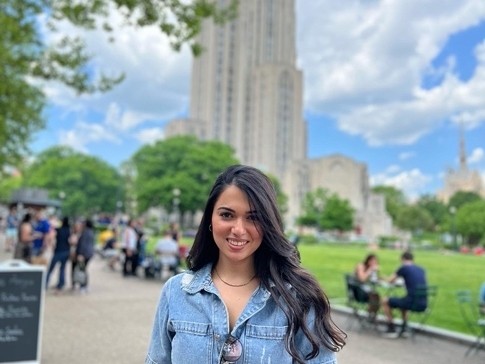Supporting the future of cardiovascular research
Four Pitt Graduate Students Receive American Heart Association Predoctoral Fellowships
Four graduate students at the University of Pittsburgh Swanson School of Engineering have received American Heart Association (AHA) predoctoral fellowships, which support the next generation of heart health researchers. The program provides funding and mentorship to outstanding doctoral students who are committed to advancing the fight against heart disease and stroke.
The predoctoral fellowship program funds up to three years of graduate study for students pursuing a PhD in fields related to cardiovascular research. The program will also provide mentorship opportunities for students to work with some of the leading scientists and clinicians in the field of cardiovascular research.
"We are delighted to see our students receive the coveted American Heart Association predoctoral fellowships. This is a testament to their hard work, dedication, and passion for creating knowledge in the cardiovascular arena and advancing the fight against heart disease and stroke,” said Sanjeev Shroff, InterimU.S. Steel Dean of Engineering. “This fellowship will not only support their research but also provide them opportunities to work with leading scientists and clinicians in the field who will serve as their mentors. The AHA fellowship is a valuable step in their journey to becoming future leaders in the field of cardiovascular research."
This year’s AHA predoctoral fellows are:

Matthew Borrelli
Advisor: Steven Little (primary advisor, Department of Chemical and Petroleum Engineering) and Heth Turnquist (co-advisor, Department of Immunology)
Project: Local Enhancement of Regulatory T Cells for the Treatment of Myocardial Infarction
Matthew Borrelli’s project will develop a new way to address the damage caused by the immune system after a heart attack. The body uses a specific cell type called regulatory T cells (Treg) to control inflammation. Tregs tell other immune cells to stop causing inflammation and instead focus on healing. Previous research found a way to locally increase the number of Treg by delivering natural signals (proteins) that can attract or induce Tregs. This technology causes more Tregs to be present and reduces inflammation. To further investigate this approach in heart attack, this project shifts its focus to an injectable technology. Borrelli will use this injectable approach to attract Tregs to the heart and improve their repair function. A separate approach will create Tregs from other immune cells that enter the damaged heart.

Ande Marini
Advisor: Justin Weinbaum, Department of Bioengineering
Project: Extracellular vesicle delivery system for treatment for Abdominal Aortic Aneurysm
Ande Marini’s work in the Vascular Bioengineering Laboratory will develop and characterize a localized controlled release system for adipose stem cell derived extracellular vesicles (EVs) and experimentally and computational analyze EV diffusion into aortic tissue. The eventual goal is fabrication of a local periadventitial abdominal aortic aneurysm (AAA) treatment. If successful, the results of this project will lay the groundwork for a novel regenerative treatment for small AAAs to prevent pre-threshold rupture and halt aneurysm growth. Marini intends to pursue a career in research as a professor, continuing her engineering-based research for the treatment of cardiovascular diseases.

Lee Ohayon-Steckle
Advisor: Partha Dutta, Department of Bioengineering, Department of Medicine and Department of Immunology
Project: The role of platelet-derived extracellular vesicles in inflammation post myocardial infarction
Lee Ohayon-Steckle’s project in the Dutta Lab will discern the role of platelet-derived extracellular vesicles (pEV) in myocardial infarction. Specifically, she will assess how pEV triggers proliferation and differentiation of hematopoietic stem and progenitor cells in the bone marrow, resulting in exaggerated inflammation. Extracellular vesicles (EVs) mediate long distance signals by delivering bioactive molecules to recipient cells and tissues, resulting in alteration in cell phenotype, gene expression, and biological pathways. Previous research showed that pEV isolated from mice with myocardial infarction had increased miR-184 content, and miR-184 overexpression in HSPC resulted in increased differentiation and myeloid cell production. Ohayon-Steckle’s project hypothesizes that increased miR-184 in pEV following MI increases HSPC proliferation, inflammatory cell generation and cardiac remodeling.

Adiya Rakymzhan
Advisor: Alberto Vazquez, Department of Bioengineering
Project: The Role of Cerebrovascular Fluctuations in Reducing Alzheimer’s Pathology
One function of blood vessels in the brain is to clear waste from the brain. Among those waste products are amyloid plaques, which are toxic proteins collected in the brain of Alzheimer’s disease (AD) patients. New brain stimulation studies suggest that gamma wave activity in the brain lowers the amyloid load. Although these studies offer promise as a potential AD therapy, it is still unclear what underlies this therapeutic effect. In this project in the NeuroImaging Laboratory, Adiya Rakymzhan will ask whether vessel pulsatile motion can explain the clearance effect of gamma waves. To answer this question, she will be using a combination of advanced genetic, optical and brain recording methods in mice. She will apply two types of treatment in an AD mouse model—gamma waves and induction of vessel pulsatile motion—and compare which one is more effective at clearing the amyloid plaques. This study will show a likely critical role that vessels play in maintaining brain health and managing waste clearance, which might lead to novel vessel-centered therapies for treating AD patients. Rakymzhan is the first international student from Kazakhstan to receive this award.
